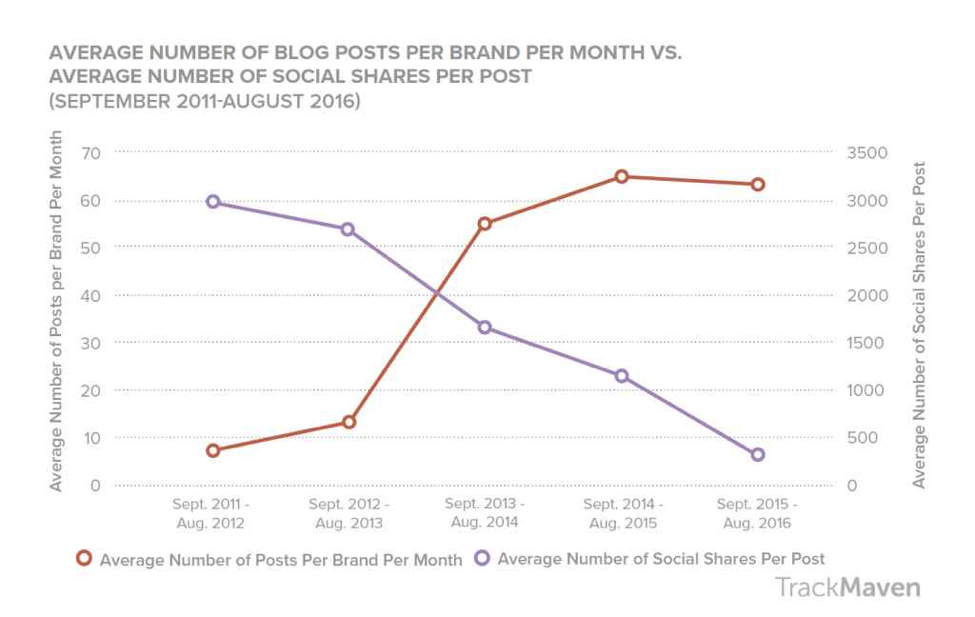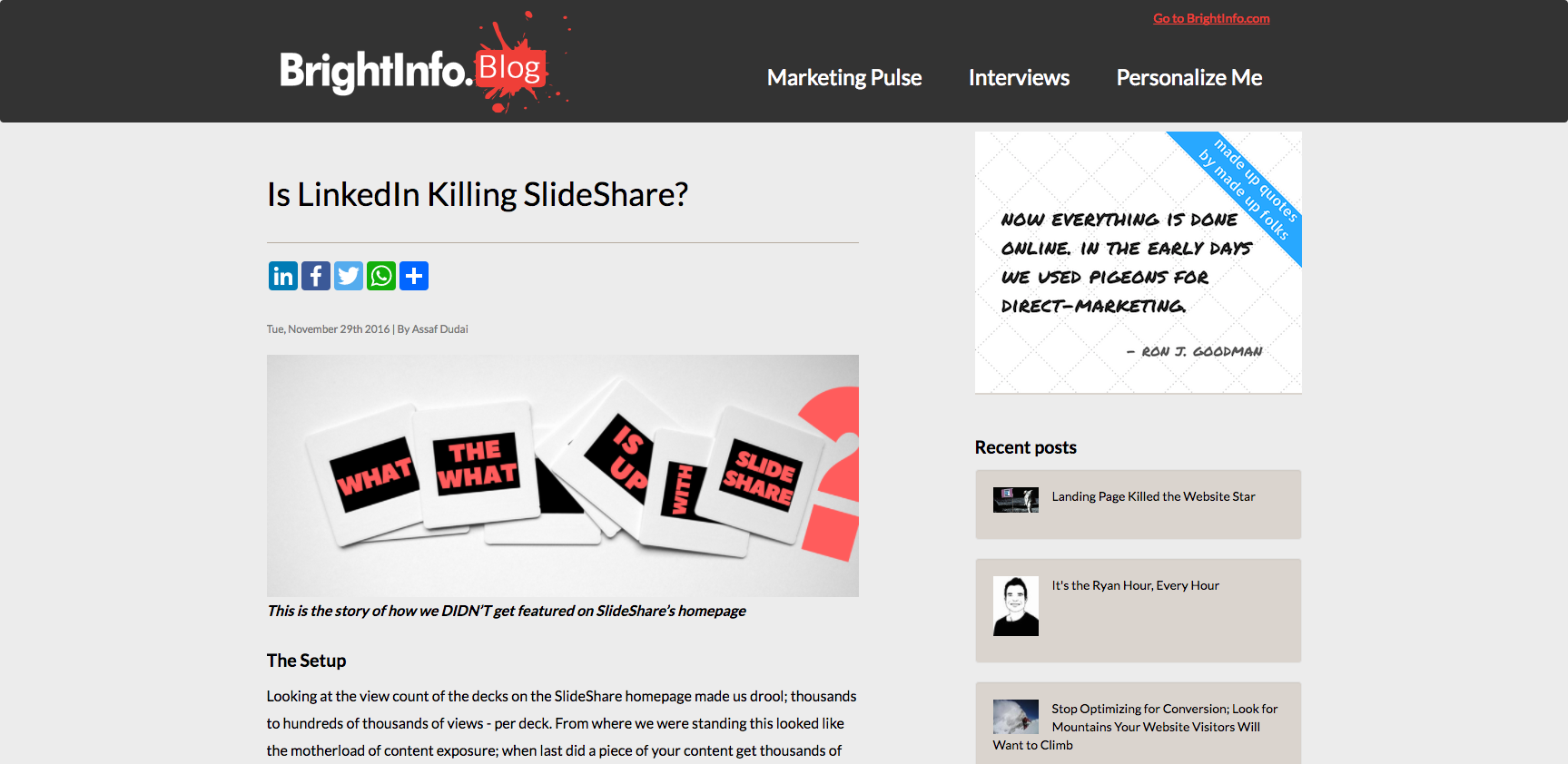- Share The Mega Post: Think Bigger About Content on Facebook
- Share The Mega Post: Think Bigger About Content on Twitter
- Share The Mega Post: Think Bigger About Content on Linkedin
- Share The Mega Post: Think Bigger About Content via email
When it comes to content strategy, a lot has been said about the importance of keeping a steady stream of fresh content flowing through your distribution channels. Marketers have listened. According to the Content Marketing Institute (CMI), 76 percent of content marketers produced more content in 2016 than they did in 2015. That content stream will only increase in 2017.
This trend has been with us for years. According to an October 2016 TrackMaven blogging report:
Over the last five years, the average number of blog posts published per brand per month increased by 800 percent. However, over the same time the average number of social shares per post (from Facebook, Twitter, LinkedIn, and Pinterest) decreased by 89 percent.

From content creation to content curation, marketers are encouraged to keep ‘em coming as part of their content strategy. But by whom?
Other marketers.
Has anyone asked readers about their preferences in regards to the content flood? I couldn’t find any stats regarding reader satisfaction with content published, or the percentage of content actually read, as opposed to just shared.
It seems uncontroversial to acknowledge that readers feel overwhelmed by the volume of content they’re exposed to every hour of every day. One result of this content flood is that the majority of published content reaches fewer eyeballs, and/or holds them for less time.
We only have so much attention, and it’s a numbers game—the more pieces of content being published daily, the less attention each gets.
That leaves marketers in a predicament. Should you keep increasing your publication rate, knowing that most pieces get very little attention, if any?
There is another option: to hold against the winds of quantity, and think of a different content strategy.
Quantity Tramples Quality

Imagine if your favorite artist released a new album every two months. Even if they maintained their quality control, you’d probably be bored with them in less than a year. But it’s likely that the fifth (or maybe even the fourth) album of the year would almost certainly be crap. There’s only so much we can produce without wearing out. (Curating other’s high quality content is the savvy way to keep a consistent publishing schedule without wearing out. Check out The Definitive Guide to Content Curation for more.)
Woody Allen is a classic example. He can’t stop himself from writing and directing a film every year like clockwork. The last year he skipped was 1981. With due admiration for Allen’s work ethic and vast ouvre, in the last two decades he had more than a few misses. Quantity eventually tramples quality.
Which brings us back to content strategy. Over-creating content doesn’t serve a strong purpose other than feeding our self-made content machines. If the remarkable Woody Allen can’t create a great film once a year, why do we, a bunch of marketers, think we can create a meaningful, insightful, original, and interesting piece of content every single day?

Introducing the Mega Post
I want to argue for a content strategy that utilizes a mega post. Unlike the daily post, the mega post is heavily invested in. It is well researched, written and revised with care and attention, and most importantly, arises from very specific circumstances:
- When you have something meaningful to say
- When this meaningful thing hasn’t been said by others yesterday, or last week
On top of easing the content flood, and allowing every piece of content to get more attention and respect, the mega post serves three purposes simultaneously:
- Creating a social buzz
- Driving traffic to your website
- Generating inbound links
The mega post can be informative in nature, but is distinguished from evergreen content by having an element of newsworthiness. No, we aren’t news reporters and we’re not going to uncover the next big scandal. When I say ‘newsworthy’ in relation to content marketing, it echoes the two circumstances I mentioned above.
An original, impactful thought is by itself newsworthy in our industry. It’s something folks want to read, share, and quote. And insightful, researched, original content is great for repurposing and atomizing into smaller chunks, to form the foundation of an entire content strategy.
You Don’t Need to Choose
I’m not arguing for the abolishment of all daily posts. There is certainly a large audience for the informative, actionable content so prevalent today. “5 Tactics for…”/“10 Hacks for…”/“How We…”/Best Practices of…” These are valuable insights and tools that we constantly share with each other, and that is very cool of us. Really. I learned a ton from reading stuff other marketers write online.
So there’s a place for both mega posts and daily posts in any content strategy. But we need to adjust the balance. We need to tip the scale more towards mega posts.
Understanding the mega benefits of the mega post is a good place to start. Curata used its analytics software—Curata CMP—and found that Curata’s long form blog posts generated 29 times more leads than short form blog posts did.
The Value of the Mega Post Content Strategy
Coming up with the idea for a mega post is no walk in the park. I read through all of Google’s first page results for “content ideation” and realized that “idea” isn’t the right word for a mega post. Ideas are for daily posts. Usually, you can’t brainstorm your way to a mega post. You need to crush into it; to either have a singular thought, or something in your environment reveals itself to you.
Still, you should put “mega post” in your editorial calendar (and check out this Ultimate List of Content Marketing Editorial Calendar Templates to find the perfect calendar for you). If it’s something you are aware of and aim for, deadline pressure will improve your chances of coming up with one.
I will use a post from my employer, BrightInfo, to illustrate how a mega post isn’t planned in the generic sense of the word, but arises from circumstances. Regardless, it needs a strong guiding hand and tons of hard work.
I will also illustrate how the three benefits of the mega post—buzz, traffic, and links—come into play.
Background: How a Mega Post is Born
Let’s do this in bullets:
- We came across a post titled something like, “How we got featured on SlideShare’s homepage and had a gazillion views.” It was a convincing, actionable post.
- We decided we wanted to be featured on SlideShare’s homepage too.
- Upon further research we concluded that we need strong content, wrapped in a unique concept, that was visually captivating in order to get the editors’ attention. (The SlideShare homepage is curated by humans.)
- A few weeks to zoom in on a promising concept: a collaboration with Dribbble designers for an illustrated guide titled “The Content Journey.”
- A few more weeks to write it, and to contact dozens of designers on Dribbble to interest them in the project.
- Finally settled on 14 designers. Each got a portion of the text to work on. This took a few more weeks.
- A couple of weeks of post-production and we were ready.
Adjusting Mid-Stride
The thing is, this isn’t even the mega post. It’s a mega post we planned for, but the real mega post was born out of the work on the deck.
We noticed the SlideShare homepage went stagnant. No new “Today’s Top,” no new “Featured.” A month went by—nada. We wrote to them. They replied that all was well, and encouraged us to try and get featured.
We thought, “That’s weird.”
We decided to proceed with our detailed plan to get featured, even though it was obvious there was something fishy going on with SlideShare. Why? Because of two reasons:
- We had an impressive deck in our hands
- If it didn’t work, we could write about How We Didn’t Get Featured
We went ahead and published the deck on SlideShare and followed our plan of distribution. (See The Ultimate List of Content Promotion Tools for the best content distribution tools on the market.) We constructed our plan meticulously, using multiple resources that had done it before and written about it.
The distribution worked great—better than anticipated—and we got thousands of views in a few days. There were hundreds of social shares, and five high-level marketing blogs republished the deck.
We didn’t get featured on SlideShare’s homepage though. Two months later it remained stagnant with no change in the featured decks.
So we started working on a post titled “Is LinkedIn Killing SlideShare?” This turned out to be a true Mega Post.
Voila! Buzz, Traffic, Links
You want and expect buzz and traffic from every post. They’re the fundamental drivers of content. If your content can’t create a buzz, and the buzz doesn’t generate traffic to your website, why write in the first place?
There are of course other goals for content creation. To educate, establish thought leadership, elevate brand awareness. But if content doesn’t generate traffic, marketers would need to come up with a different tactic to spearhead B2B marketing.
A mega post should create a spike in your traffic metrics. Something like this:

Buzz leads to traffic, and buzz starts with a strong headline. We’re not going to get into clickbait and headline crafting; enough has been written about these two subjects. Let’s just say that the Oxford Dictionary defines clickbait as “content whose main purpose is to attract attention and encourage visitors to click on a link to a particular web page.” Please remember that the size of expectation is proportionate to the size of disappointment—and folks don’t forgive easily.
Free Promotion
Besides a strong title, authority figures in your industry can also greatly help with social buzz. Some refer to it as influencer marketing. Without it, we would never have managed to create the perfect Twitter storm that erupted around our mega post. Not to mention the massive sharing we got on LinkedIn itself (the irony!).
As the previous Google analytics screen grab illustrates, the storm lasted quite a few days and sent traffic to our site in volumes we were unaccustomed to. This was in large part due to the fact that we grabbed the top spot in Inbound.org’s Sunday Mail two weeks in a row. They stamped our submission with a “newsworthy” top banner, and that made a big difference.

What truly separates the mega post from a daily post is backlinks. Sites will link back to your mega post because, as mentioned earlier, it’s newsworthy—it’s worth repeating. Websites and publications want to share it with their audience, and will swallow their pride if they’re not the one who came up with it.
The After-Effect of Backlinks
The value of backlinks far exceeds that of buzz and traffic. Obviously backlinking won’t happen without buzz and traffic; it also doesn’t work the other way around.
The difference between buzz and backlinks is like the difference between being handed a corn cob, and inheriting a parcel of land planted with corn.
Your website benefits from the backlinks generated by a mega post long after the buzz and traffic subside. Backlinks are the foundation of any B2B SEO content strategy as far as positioning your website and brand as an authoritative resource. The more high quality third-party websites link back to your post, the more trust Google places in it as a reliable source. When users search for information and your mega post appears among Google’s top results, this is as good as it gets online.
How do You Generate Backlinks?
This question is as old as the Internet itself. If buzz creates traffic which leads to backlinks—you might assume that backlinks happen naturally to validate your mega post. They do, but you can magnify this process considerably with effective content distribution.
While you’re getting ready to publish your mega post, conduct research on third-party blogs and publications that cater to your industry, and shoulder-industries. (These are any industries that might find your post interesting, given subject matter overlap.)
After the post is published, send an email blast announcing the publication and suggest they cover the “news” for their audience. Offer to provide any additional information they might request that is relevant to their readership.
Most publications appreciate a quality, original, well-researched and reasoned piece of content. All content marketers are chasing their tails for quality content. If it comes to their doorstep, they’re generally receptive.
Rein in Content Creation

According to CMI, 55 percent of B2B marketers aren’t sure what effective content is. And TopRank Marketing finds that 60 percent admit to struggling to produce engaging content. There’s no nice way to put this: more than half of marketers are creating content that by their own admission, isn’t engaging or effective.
It isn’t hard to speculate about the reason why.
The pressure to keep pace means B2B content marketers often turn out hurried, thoughtless, throwaway content far more often than they want to.
It’s time to call back the troops and adopt a more restrained and thoughtful content strategy. One that results in not just “content,” but meaningful content that can delight your audience. Refocus your resources away from constant short form content, towards more in-depth long form content, and you’ll reap the marketing rewards.
If you’d like to find out more about the mega post and the pyramid content strategy, join myself, Assaf Dudai, and Curata’s director of content marketing, Mitchell Hall, for the webinar: How to Create a Traffic Magnet.












